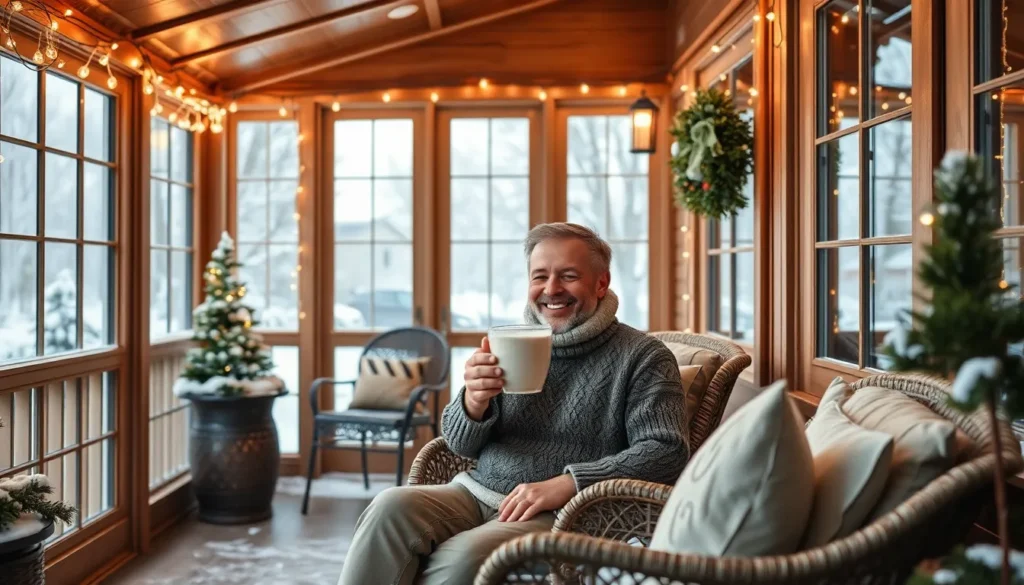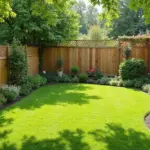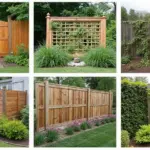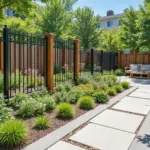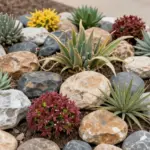Winter doesn’t have to mean abandoning your favorite outdoor space. We’ve all experienced that moment when the temperature drops and we’re forced to retreat indoors, watching our beautiful porches sit empty for months. But what if we told you there’s a way to extend your porch season well into the colder months?
Porch enclosures are game-changers that transform your outdoor sanctuary into a cozy winter retreat. Whether you’re dreaming of sipping hot cocoa while watching snowfall or hosting intimate gatherings even though the chill, the right enclosure solution can make it happen.
We’ll explore creative and practical winter porch enclosure ideas that fit every budget and style preference. From temporary seasonal answers to permanent installations, these strategies will help you reclaim your porch space and enjoy it year-round. Get ready to discover how simple modifications can turn your porch into the winter haven you never knew you needed.
Glass Panel Enclosures for Maximum Light and Warmth
Glass panel enclosures offer the perfect balance between protection and openness for your winter porch retreat. These transparent barriers create a comfortable indoor environment while maintaining the visual connection to your outdoor surroundings.
Tempered Glass Installation Benefits
Tempered glass provides superior safety and durability compared to standard glass options. This specially treated material is four times stronger than regular glass and shatters into small, rounded pieces rather than dangerous shards if broken. Weather resistance becomes exceptional with tempered glass, as it withstands temperature fluctuations from -40°F to 470°F without cracking or warping.
Energy efficiency improves significantly when we install tempered glass panels on our porches. The material reduces heat loss by up to 50% compared to open porches, creating substantial savings on heating costs during winter months. Maintenance requirements stay minimal since tempered glass resists scratches, stains, and weather damage better than other enclosure materials.
Installation flexibility allows for custom configurations that match your porch’s unique dimensions and architectural style. Professional installers can create floor-to-ceiling panels, half-wall installations, or sectioned designs that accommodate existing porch features like columns or railings.
Sliding Glass Door Options
Sliding glass doors maximize accessibility while providing complete weather protection for your enclosed porch. These systems typically feature two to four panel configurations that glide smoothly on aluminum or steel tracks. Space efficiency becomes a major advantage since sliding doors don’t require clearance for opening like traditional hinged doors.
Heavy-duty track systems support panels weighing up to 300 pounds each, ensuring smooth operation even with large glass installations. Weather sealing technology in modern sliding systems includes multiple gasket layers and compression locks that prevent drafts and moisture infiltration. Screen integration options allow you to enjoy fresh air during milder winter days while keeping insects out.
Customization possibilities include various frame materials such as aluminum, vinyl, or wood-clad options that complement your home’s exterior design. Glass thickness typically ranges from 6mm to 12mm, with thicker options providing better insulation and noise reduction.
Insulated Glass Panel Systems
Insulated glass panels feature dual or triple pane construction that traps air or gas between glass layers for superior thermal performance. These systems reduce heat transfer by up to 70% compared to single-pane installations, making them ideal for harsh winter climates. Argon gas fills commonly used between panes provide better insulation than air-filled alternatives.
Low-E coating applications reflect infrared heat back into your porch while allowing visible light to pass through. This technology maintains comfortable temperatures while preventing furniture fading and reducing glare. Spacer systems made from warm-edge materials like foam or fiberglass minimize thermal bridging at panel edges.
Condensation control becomes effortless with properly installed insulated glass systems that maintain consistent interior temperatures. Desiccant materials within the sealed air space absorb moisture and prevent fogging between panes. Professional installation ensures proper sealing and optimal performance for decades of reliable use.
Vinyl Window Enclosures for Budget-Friendly Protection
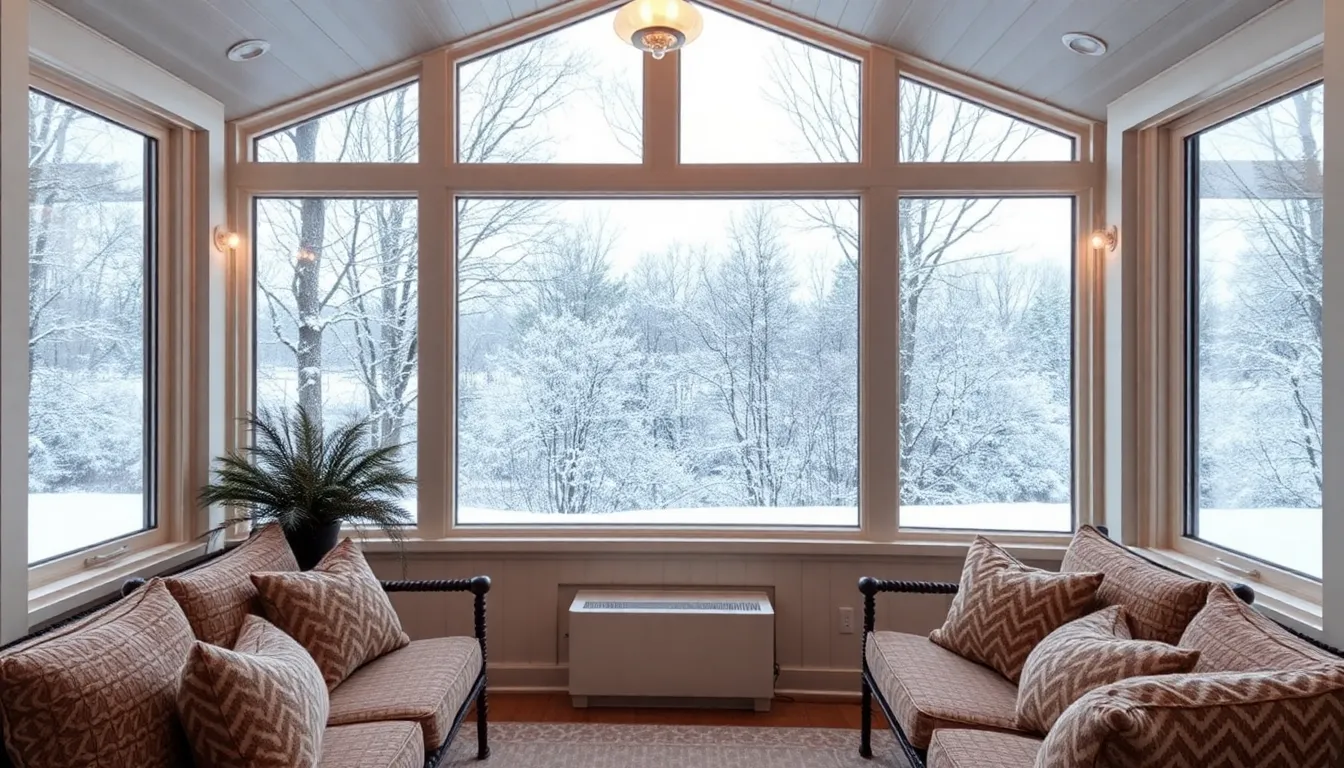
Vinyl window enclosures offer an affordable alternative to glass panels while delivering excellent winter protection for your porch. We’ve found these answers particularly effective for homeowners seeking temporary yet durable weatherproofing options.
Three-Season Room Conversion
Converting your screened porch into a three-season room extends usability through fall, winter, and spring months. This upgrade involves installing insulated windows and sometimes adding heating elements to create a semi-permanent enclosed space. Energy-efficient windows enhance climate control while maintaining the porch’s original character.
Custom enclosures customized to your porch dimensions improve both aesthetics and performance compared to standard sizes. We recommend this approach for porches with solid structural foundations that can support additional window weight. Three-season conversions cost significantly less than full winterized rooms while offering superior comfort over basic vinyl panels.
Removable Vinyl Panel Systems
Removable vinyl panel systems provide maximum flexibility for seasonal porch use. These systems feature clear, heavy-duty vinyl panels reinforced with fabric webbing that mount using tracks or zippers for easy installation and removal.
Custom-made panels ensure a perfect fit for any porch size and outperform generic fabric curtains in both durability and weather resistance. We’ve seen these panels effectively block snow, wind, sleet, and cold air while maintaining visibility and natural light penetration. Installation typically takes just a few hours, and the panels store compactly during warmer months when you want an open porch experience.
Weatherproofing Techniques
Maximizing your vinyl enclosure’s effectiveness requires proper weatherproofing techniques that seal gaps and enhance insulation. Weather stripping around doors and windows creates airtight seals that prevent cold air infiltration and reduce heating costs.
Insulated window treatments or thermal curtains add an extra layer of warmth retention when temperatures drop significantly. We recommend ensuring proper drainage and roof sealing to prevent ice dam formation that could damage your enclosure system. Adding portable heaters or radiant floor heating elements maintains comfortable temperatures throughout the winter season.
| Weatherproofing Method | Cost Range | Effectiveness | Installation Time |
|---|---|---|---|
| Weather Stripping | $50-$150 | High | 2-4 hours |
| Thermal Curtains | $100-$300 | Medium | 1-2 hours |
| Portable Heaters | $75-$400 | High | 30 minutes |
| Radiant Floor Heating | $500-$1,500 | Very High | 4-8 hours |
Combining multiple weatherproofing techniques with your vinyl enclosure creates a well-insulated winter space that rivals more expensive permanent answers.
Screen Room Conversions with Winter Storm Panels
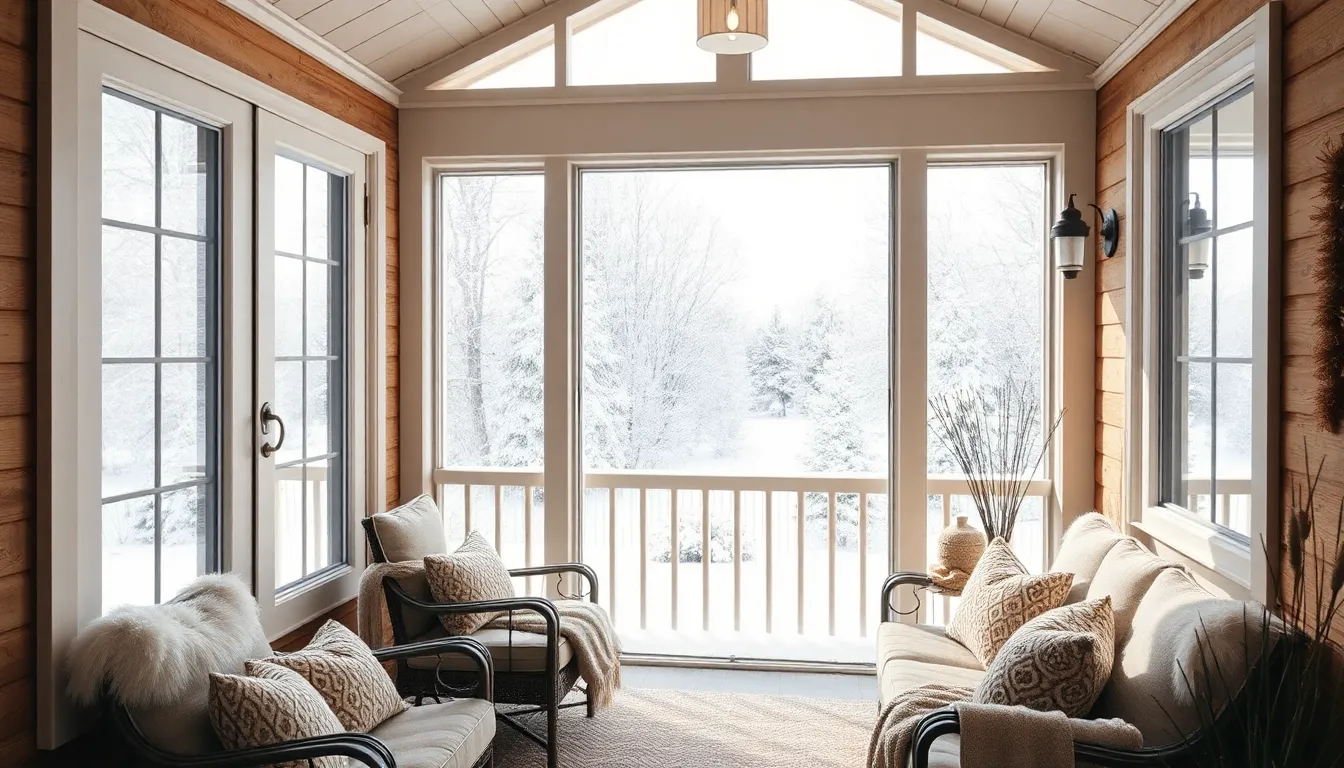
Converting your existing screened porch into a winter sanctuary doesn’t require extensive renovation when you use the right storm panel answers. We’ll explore versatile conversion methods that transform seasonal spaces into year-round comfort zones.
Zip-On Storm Panel Answers
Zip-on storm panels deliver the perfect balance of convenience and protection for winter porch conversions. These innovative panels attach securely to your existing porch frame using a zipper system that creates an airtight seal against winter elements. We love how easily they install without requiring permanent modifications to your porch structure.
Installation typically takes just a few hours, making this solution ideal for homeowners who want quick winter protection. The panels use heavy-duty zippers that withstand repeated use throughout multiple seasons. Most systems feature clear vinyl construction that maintains visibility while blocking wind, snow, and cold air effectively.
Removal becomes effortless when spring arrives, allowing you to store the panels until the next winter season. The flexibility of zip-on systems means you can partially enclose your porch on milder days or fully seal it during harsh weather conditions.
Clear Vinyl Storm Windows
Clear vinyl storm windows offer an economical approach to winter porch enclosures with impressive durability and weather resistance. These windows typically use 20 mil thick transparent vinyl that provides excellent protection while preserving natural light and outdoor views. We recommend custom-sized panels for the best fit and maximum draft prevention.
Heavy-duty vinyl construction resists tearing, cracking, and UV damage throughout multiple winter seasons. The material’s flexibility allows it to expand and contract with temperature changes without compromising the seal. Most installations require minimal tools and can be completed by homeowners with basic DIY skills.
Maintenance involves simple cleaning with mild soap and water to keep the vinyl clear and functional. Storage becomes manageable since vinyl panels fold compactly when not in use. The cost-effectiveness of vinyl storm windows makes them accessible for most budgets while delivering reliable winter protection.
Combination Screen and Glass Systems
Combination screen and glass systems provide the ultimate flexibility for porch enclosures that adapt to changing weather conditions. These systems incorporate both screening for mild weather ventilation and glass or clear panels for complete winter protection. We appreciate how this dual approach maximizes your porch’s usability across all seasons.
Glass components offer permanent insulation that can transform your porch into a comfortable sunroom environment during winter months. The screening elements allow for airflow during transitional seasons when complete enclosure isn’t necessary. Many systems feature interchangeable panels that you can swap based on weather conditions and personal preferences.
Professional installation ensures proper sealing and structural integrity for combination systems. The investment in this type of enclosure pays dividends through extended porch usage and potential increases in home value. Most combination systems accommodate various architectural styles while providing superior weather protection compared to single-material answers.
Wooden Frame Enclosures with Insulation Options
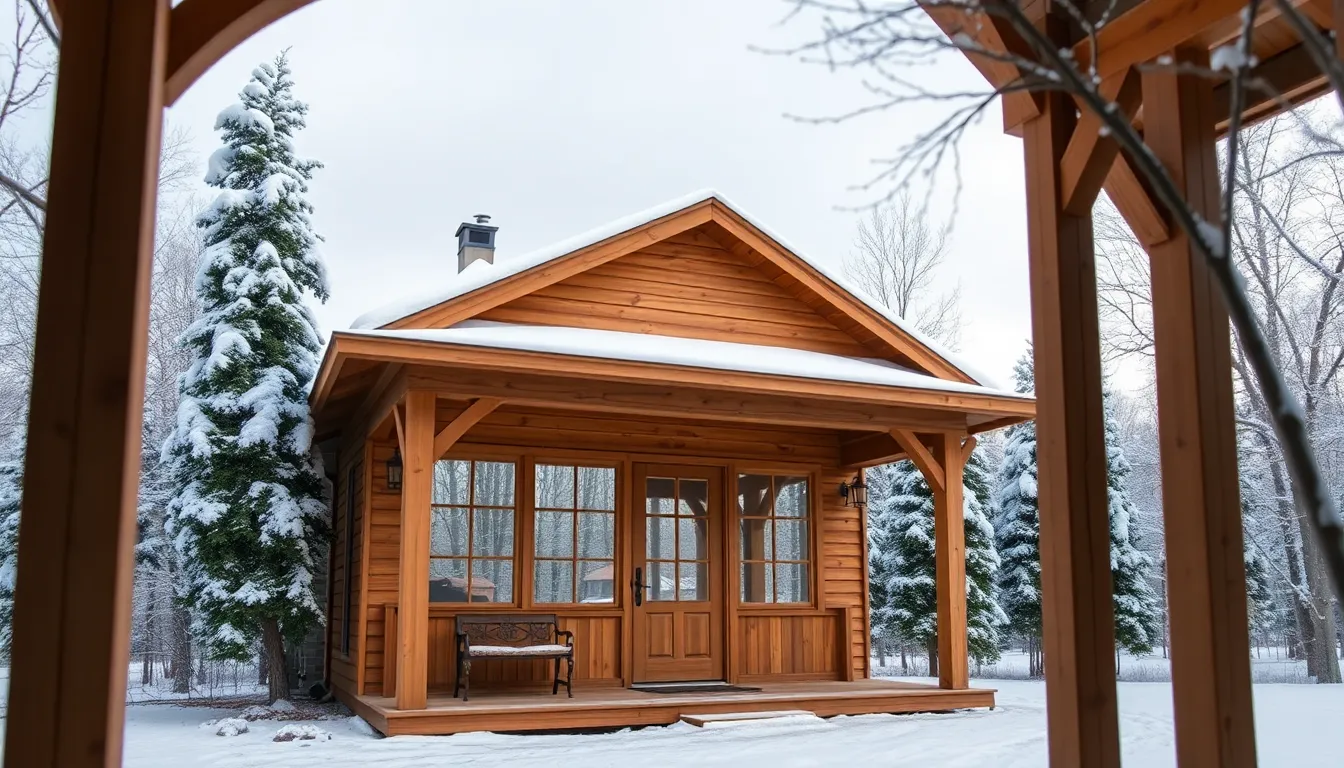
Building on the foundation of effective winter porch answers, wooden frame enclosures offer a perfect blend of durability and natural beauty. These structures provide the structural integrity needed for insulation materials while creating a warm, inviting space that complements your home’s architecture.
Cedar and Composite Frame Materials
Cedar stands out as our top choice for porch frame materials due to its exceptional resistance to moisture, decay, and insects. This natural wood performs exceptionally well during harsh winter conditions while maintaining its structural integrity season after season. We recommend cedar frames because they naturally repel pests and resist rot without requiring extensive chemical treatments.
Composite materials present another excellent option, combining wood fibers with plastic to create low maintenance frames that withstand snow and ice. These materials offer superior weather resistance compared to traditional wood while requiring minimal upkeep throughout winter months. Homeowners appreciate composite frames because they won’t warp, crack, or split under extreme temperature fluctuations.
Both cedar and composite materials can be finished to match your home’s exterior design while providing the strength needed for proper insulation installation. Frame customization options allow you to select colors and textures that enhance your property’s curb appeal while delivering long term durability.
Double-Wall Insulation Methods
Double-wall insulation creates a highly effective thermal barrier by installing two separate wall systems with an air gap or insulation material between them. We achieve this by combining an exterior transparent wall made of glass or acrylic with an interior insulated wall section. This layered approach significantly reduces thermal bridging and improves energy efficiency during winter months.
Foam board insulation works particularly well within wooden frame cavities, providing excellent R-value while remaining lightweight and easy to install. Fiberglass insulation offers another reliable option for filling frame spaces, creating effective barriers against cold air infiltration. Professional installation ensures proper vapor barriers and eliminates thermal bridges that could reduce overall system performance.
Air gap spacing between walls typically ranges from 2 to 4 inches, allowing for optimal insulation thickness while maintaining structural stability. This method keeps enclosed spaces consistently warmer while reducing heating costs throughout the winter season.
Traditional Storm Window Installation
Storm windows represent a classic and cost effective approach to winterizing porch spaces without major structural modifications. We install these protective barriers either inside or outside existing windows or screened areas to create an additional layer of defense against cold air and precipitation. This traditional method allows homeowners to maintain their porch’s original character while adding seasonal protection.
Glass storm windows provide superior insulation and visibility compared to plastic alternatives, though they require more careful handling during installation. Polycarbonate storm windows offer excellent durability and impact resistance while remaining lighter than glass options. Both materials can be framed with aluminum or wood to match your existing porch design.
Installation involves securing storm windows directly to existing frame structures using weatherproof mounting hardware. Proper sealing around all edges prevents drafts while allowing easy removal when warmer weather returns. This flexibility makes storm windows ideal for homeowners who prefer seasonal rather than permanent modifications to their outdoor spaces.
Retractable Enclosure Systems for Year-Round Flexibility
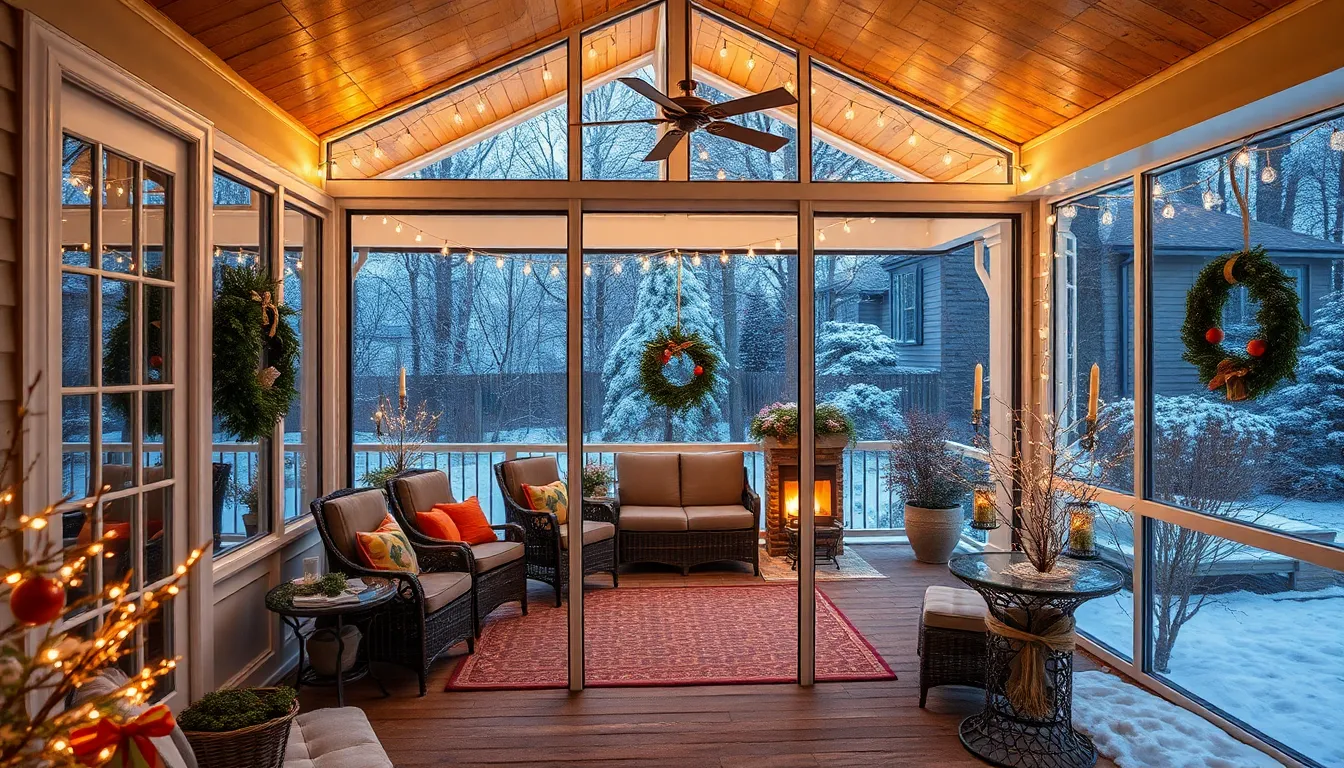
Retractable systems provide the ultimate flexibility for porch enclosures, allowing you to adapt your space instantly to changing weather conditions. These innovative answers let you enjoy an open porch during pleasant weather while quickly transforming it into a protected winter retreat.
Motorized Retractable Walls
Motorized retractable walls deliver convenience at the push of a button, making seasonal transitions effortless for busy homeowners. These automated systems use durable materials like clear vinyl or glass panels that effectively block cold air, wind, and snow while preserving your outdoor views. Installation typically involves mounting tracks to your porch frame, with panels that slide smoothly along motorized guides.
Operation requires minimal effort since you simply press a button to enclose or open your space within minutes. Clear vinyl options offer excellent weather resistance and cost less than glass alternatives, while glass panels provide superior durability and a more permanent appearance. Weather sealing technology in these systems creates an airtight barrier that significantly reduces heat loss during winter months.
Manual Roll-Up Clear Panels
Manual roll-up clear panels offer an affordable and practical solution for homeowners seeking effective winter protection without complex installation. These panels attach directly to your existing porch frame and feature thick vinyl construction that blocks sleet, wind, and snow while allowing natural light to filter through. Rolling mechanisms make seasonal storage simple, with panels that compress into compact bundles when not needed.
Customization options include various vinyl thicknesses and mounting configurations to fit different porch designs and weather exposure levels. Heavy duty grommets and reinforced edges ensure these panels withstand harsh winter conditions without tearing or pulling away from mounting points. Cost effectiveness makes this option particularly attractive, typically ranging from $200 to $800 depending on your porch size and material quality.
Accordion-Style Folding Systems
Accordion-style folding enclosures combine aesthetic appeal with practical functionality, folding neatly to one side when you want full porch access. These systems typically feature glass or durable vinyl panels connected by hinges that create a seamless barrier when closed. Professional installation ensures proper alignment and weather sealing for optimal winter performance.
Versatility allows you to partially open sections for ventilation while maintaining protection from wind and precipitation in other areas. Glass panel options provide superior insulation and a more permanent appearance, while vinyl alternatives offer flexibility and easier replacement if damage occurs. Space efficiency makes these systems ideal for smaller porches where traditional sliding doors might not fit properly.
Polycarbonate Panel Enclosures for Durability
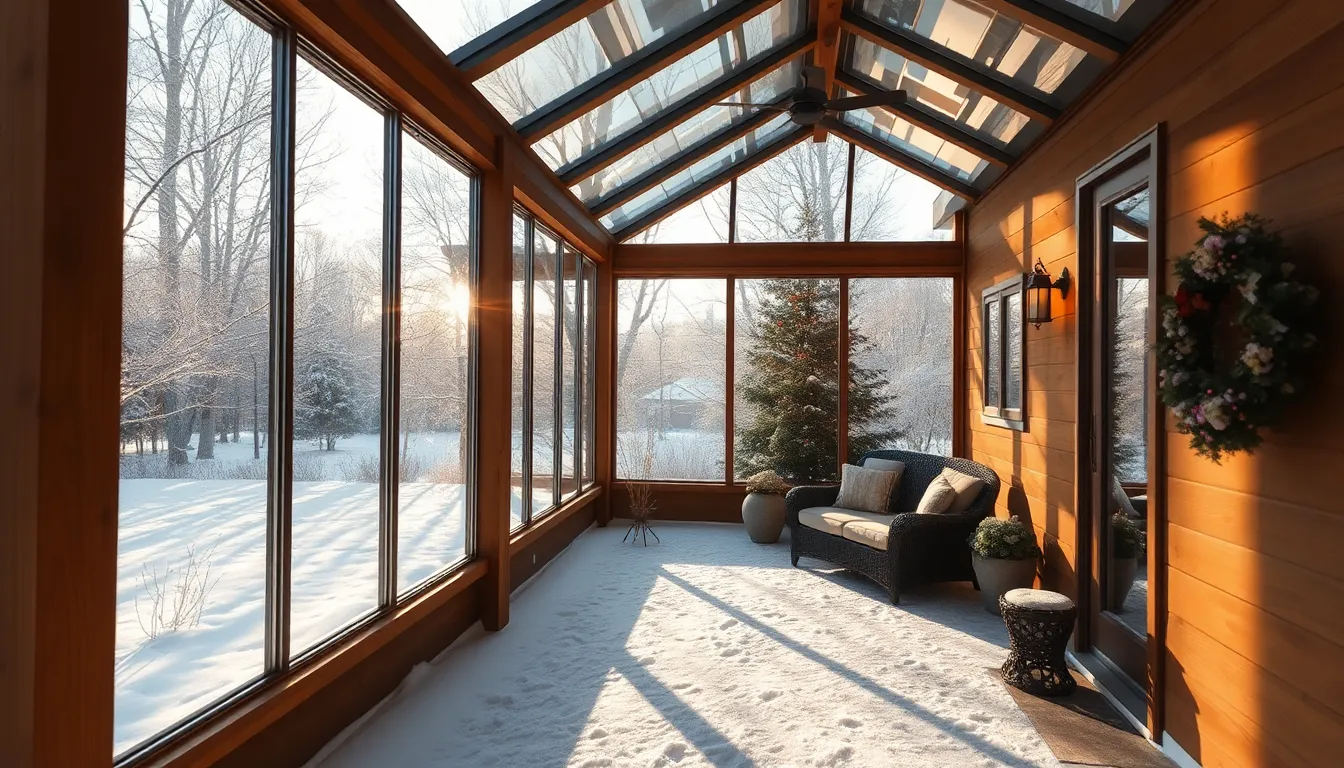
We’ve found that polycarbonate panels offer one of the most reliable answers for winter porch enclosures. These panels create a sturdy barrier against harsh winter weather like wind, snow, and sleet, helping you use your outdoor space year-round.
Multi-Wall Polycarbonate Benefits
Multi-wall polycarbonate panels feature a layered structure that significantly enhances insulation performance. This innovative design traps air between layers, improving thermal performance to keep your enclosed porch warmer during winter months. The added insulation reduces heat loss compared to single-pane alternatives, making your space more comfortable and energy efficient.
Thermal barriers created by these panels help maintain consistent temperatures inside your enclosure. Air pockets between the walls act as natural insulators, preventing cold transfer from outside surfaces. This multi-layer construction allows you to enjoy your porch even when temperatures drop significantly below freezing.
UV Protection Features
UV protective coatings on polycarbonate panels prevent material degradation and yellowing from sunlight exposure. This specialized coating ensures your enclosure maintains its clarity and structural integrity throughout winter sun exposure. The protective layer also shields occupants and furnishings from harmful UV rays that can cause fading and damage.
Long term durability is maintained through these advanced UV resistant technologies. Your investment stays protected year after year, avoiding the costly replacements often required with inferior materials. This feature becomes especially valuable during bright winter days when snow reflects additional sunlight onto your porch surfaces.
Impact Resistance Properties
Impact resistance makes polycarbonate panels highly resistant to cracking or breaking from hail, windborne debris, or accidental impacts. This exceptional durability maintains your enclosure’s integrity throughout winter storms and adverse weather conditions. The material withstands forces that would shatter traditional glass panels, providing reliable protection when you need it most.
Storm protection capabilities of these panels exceed those of conventional enclosure materials. Wind driven debris that typically damages porches during winter storms bounces off polycarbonate surfaces without causing structural compromise. This resilience ensures your enclosed space remains secure and functional regardless of weather severity.
DIY Porch Enclosure Projects for Winter Use
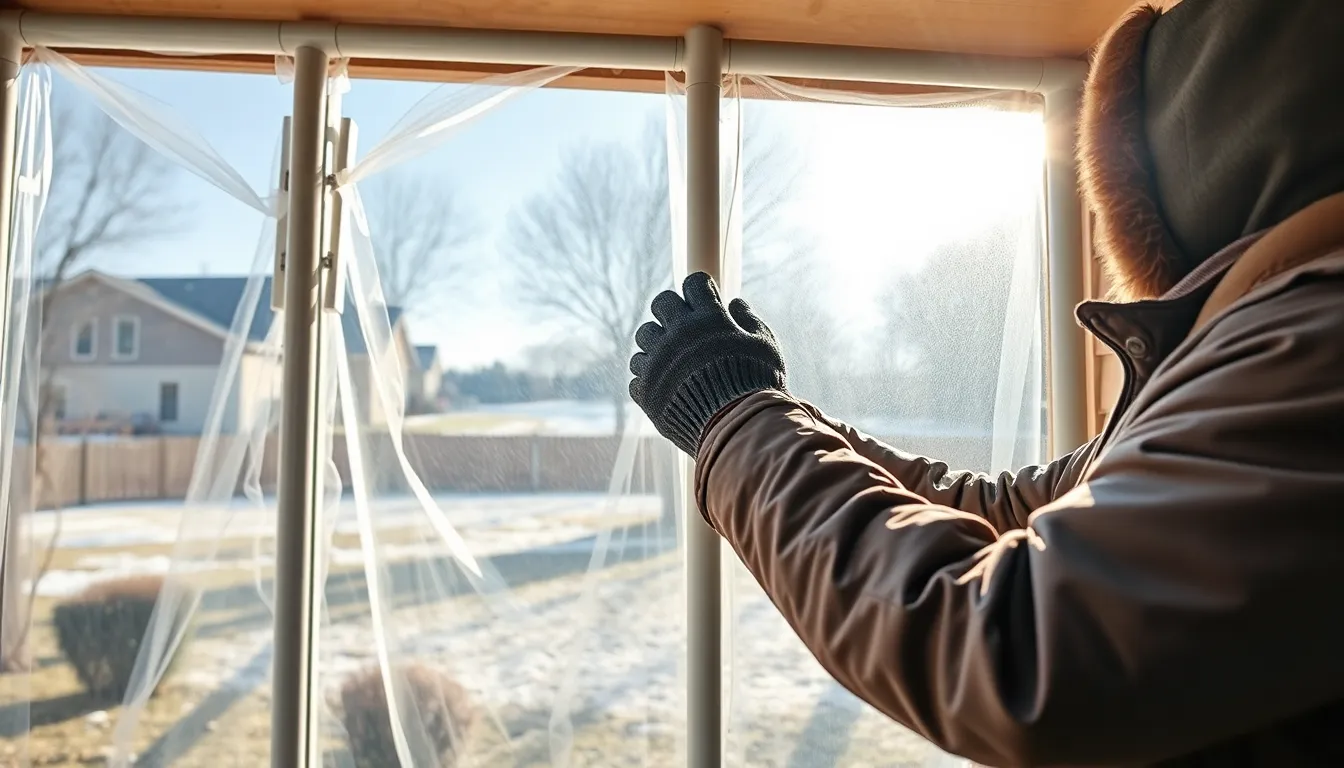
Creating your own winter porch enclosure doesn’t require professional expertise or expensive materials. We’ll explore practical DIY methods that transform your porch into a cozy winter retreat using accessible materials and straightforward techniques.
Plastic Sheeting Installation Methods
Plastic sheeting offers one of the most budget-friendly approaches to winter porch enclosures. We recommend using insulating plastic sheets like vinyl sheeting to cover porch openings effectively. Clear vinyl panels work exceptionally well when cut to size and attached with hook-and-loop fasteners or clips for easy removal during warmer months.
Installing these flexible barriers involves securing the plastic over existing porch screens or open frames to block wind and precipitation. This method provides temporary winter protection while allowing natural light to penetrate the space. Vinyl systems create an effective seal that helps retain heat and keeps your porch comfortable throughout the winter season.
Canvas and Tarp Enclosure Options
Canvas enclosures deliver durability and decent insulation properties for winter porch protection. We suggest using heavy-duty canvas materials attached to existing porch structures through grommets and bungee cords or hooks. Canvas provides superior longevity compared to plastic sheeting but may reduce light transmission into the enclosed space.
Tarps represent the most cost-effective option for quick winter enclosure installation. These materials require minimal investment and can be installed rapidly using basic hardware. Heavy-duty tarps may need more frequent adjustments or replacement due to weather exposure, but they offer immediate protection from harsh winter conditions.
PVC Pipe Frame Construction
PVC pipes create an ideal foundation for DIY porch enclosures because they’re lightweight, affordable, and simple to assemble. We construct PVC frames to match exact porch dimensions, creating a skeleton structure that supports plastic sheeting or panels. This approach enables complete customization while maintaining the option for seasonal removal and storage.
Building a PVC frame system allows for removable panels that provide easy access and ventilation control. Frame construction can accommodate various attachment points for different enclosure materials, from clear vinyl sheets to canvas panels. PVC frameworks offer the flexibility to modify your enclosure design as needs change throughout the winter season.
Professional Installation vs. DIY Considerations
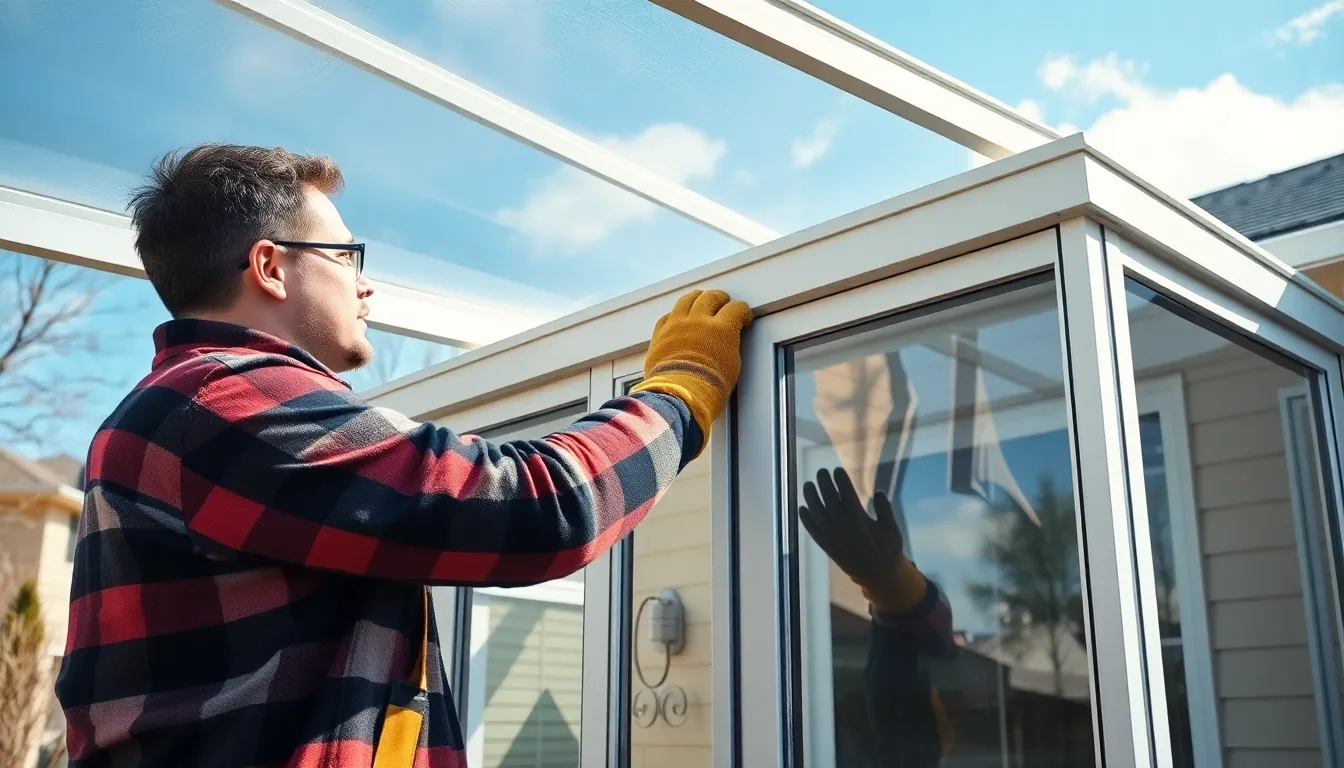
We’ve explored various porch enclosure options, and now it’s time to weigh the crucial decision between professional installation and tackling the project yourself. This choice significantly impacts your budget, timeline, and the long-term success of your winter porch enclosure.
Cost Comparison Analysis
DIY installations typically offer lower upfront costs since you’re not paying for professional labor. We can save hundreds or even thousands of dollars by purchasing DIY kits and handling the installation ourselves. But, these initial savings might not tell the complete story.
Professional installations require higher upfront investment due to labor charges, but they often deliver superior long-term value. Licensed contractors use advanced tools and techniques like Nyloc screws, proper leveling, and precise alignment that ensure durability crucial for winter conditions. We’ve found that professional installations frequently result in higher-quality finishes and longer-lasting structures that can increase home value.
Long-term costs favor professional installation when we factor in potential mistakes and rework. DIY projects risk misalignment, structural issues, or improper water drainage that could lead to expensive repairs down the road. Professional contractors complete installations more efficiently with reliable results, potentially saving money over time by avoiding these costly setbacks.
Permit Requirements and Building Codes
Building permits are required in many jurisdictions for porch enclosures due to safety, structural integrity, and zoning regulations. We must research local requirements before starting any enclosure project, as overlooking this step can result in fines or mandatory rework.
Code compliance becomes significantly easier with professional installation. Licensed contractors stay current with local building codes and ensure installations meet standards for insulation, structural support, and egress requirements essential for winterproofing. They understand complex regulations that might confuse DIY homeowners.
DIY risks include misunderstanding or overlooking permit requirements entirely. We might face legal complications, fines, or the expensive prospect of redoing work to meet compliance standards. Professional installers handle permit applications and inspections, removing this burden from homeowners.
Long-Term Maintenance Factors
Professional installations typically use higher-grade materials and weatherproof finishes that reduce wear from snow, ice, and cold temperatures. We benefit from accurate installation that minimizes water leakage and structural stress, eventually lowering future repair costs.
DIY maintenance requirements often exceed expectations, especially for poorly installed enclosures. We might face frequent repairs to address leaks, drafts, or damage caused by winter weather. DIY kits may lack detailed instructions and expertise, leading to structural issues that require ongoing attention.
Warranty coverage differs dramatically between approaches. Professional installations usually include warranties and ongoing support, while DIY projects rely entirely on our own troubleshooting and maintenance skills. We assume full responsibility for any problems that arise with self-installed enclosures.
Material durability depends heavily on installation quality. Professional contractors ensure proper drainage, alignment, and weatherproofing techniques that extend the life of enclosure materials. DIY installations without proper expertise may compromise material performance, leading to premature replacement needs.
Heating Solutions for Enclosed Winter Porches
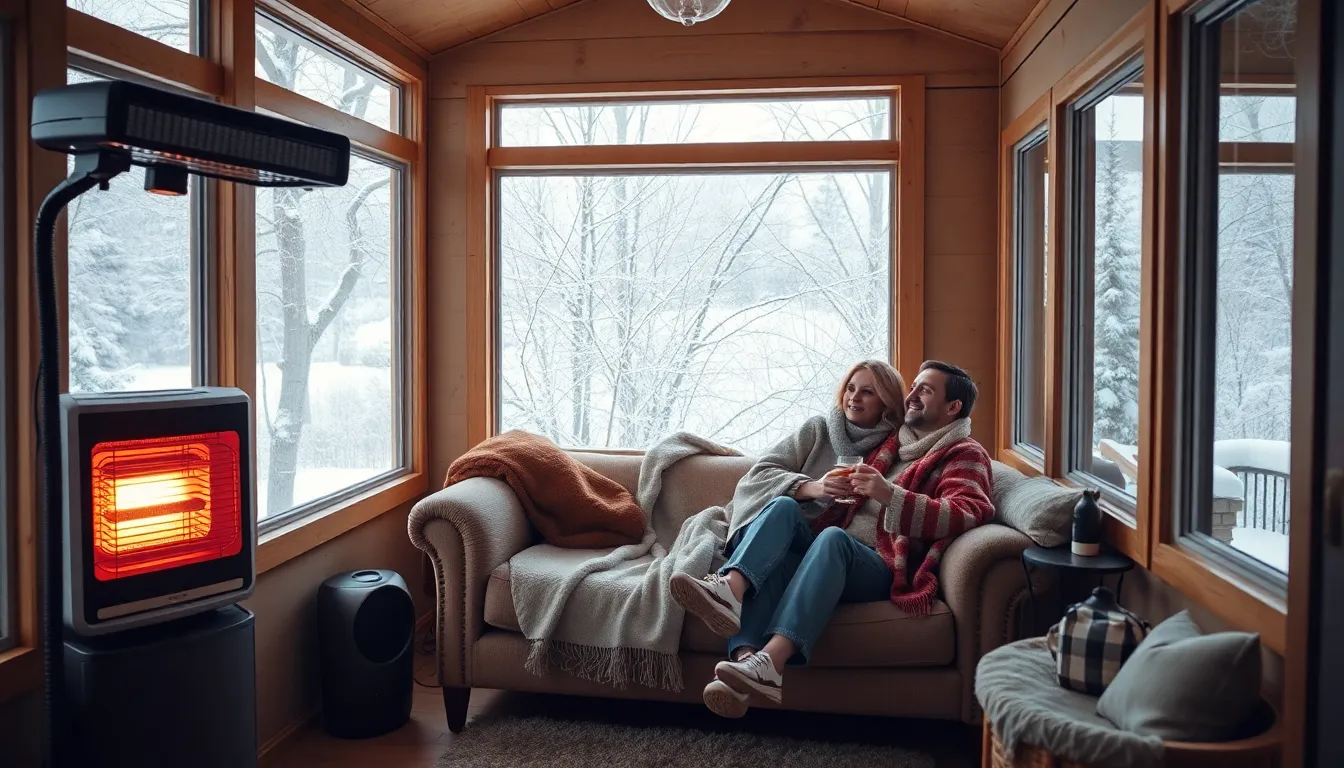
Once you’ve enclosed your porch for winter, adding proper heating transforms your space into a truly comfortable retreat. We’ll explore the most effective heating answers that work perfectly with your newly enclosed porch.
Electric Space Heater Options
Portable electric space heaters are the most popular choice for warming enclosed porch areas. These heaters come in various sizes and heating capacities, making them perfect for different porch dimensions. Ceramic heaters distribute warmth evenly while oil-filled radiators provide consistent, long-lasting heat. Space heaters offer quick warmth without requiring permanent installation, letting you move them as needed.
Energy-efficient models with programmable thermostats help control costs while maintaining comfort. Look for heaters with tip-over protection and overheat shutoff features for safety. Infrared heaters work exceptionally well in enclosed spaces, directly warming objects and people rather than just the air.
Radiant Floor Heating Systems
Radiant floor heating provides the ultimate comfort solution for enclosed winter porches. This system installs beneath your porch flooring and evenly distributes warmth from the ground up. Electric radiant mats work well for smaller enclosed porches, while hydronic systems using hot water pipes suit larger spaces.
Installation requires professional expertise but creates a cozy environment without consuming visible space or blowing air around. The system operates silently and provides consistent temperatures throughout your enclosed porch. Floor heating works particularly well with tile, stone, or concrete flooring materials that retain and radiate heat effectively.
Propane Heater Safety Guidelines
Ventilation remains critical when using propane heaters in enclosed porch spaces to prevent carbon monoxide buildup. Always ensure adequate airflow by cracking windows or installing ventilation fans. Only use propane heaters that manufacturers certify for indoor use in enclosed spaces.
Keep heaters away from flammable materials like curtains, furniture, or decorative items. Never leave propane heaters unattended while they’re operating. Install carbon monoxide detectors in your enclosed porch area for added safety protection.
Follow manufacturer instructions carefully about clearance distances from walls and ceilings. Regular maintenance includes checking connections, cleaning burner ports, and inspecting hoses for wear or damage. Store propane tanks outdoors when not in use, even in enclosed porch areas.
Conclusion
We’ve explored many porch enclosure options that’ll keep your outdoor space functional throughout winter. From budget-friendly DIY vinyl answers to sophisticated retractable systems each approach offers unique advantages for different needs and budgets.
The key to success lies in matching your enclosure choice with your exact climate conditions lifestyle requirements and long-term goals. Whether you’re installing temporary storm panels or investing in permanent glass installations proper planning ensures maximum comfort and value.
Remember that combining the right enclosure with appropriate heating answers creates a truly livable winter retreat. With these ideas and techniques you’re well-equipped to transform your porch into a cozy sanctuary that extends your living space year-round.
Frequently Asked Questions
What are the main benefits of porch enclosures for winter use?
Porch enclosures extend the usability of your outdoor space during colder months, providing protection from harsh weather while maintaining a connection to the outdoors. They significantly improve energy efficiency, reduce heating costs, and create a comfortable environment for activities like hosting gatherings or enjoying hot beverages. Additionally, they can increase your home’s value and provide year-round functionality.
Which type of porch enclosure offers the best value for money?
Vinyl window enclosures provide excellent value as a budget-friendly alternative to glass panels. They offer effective winter protection, easy installation and removal, and maintain visibility and light. When combined with proper weatherproofing techniques like weather stripping and insulated window treatments, vinyl enclosures can create well-insulated spaces that rival more expensive permanent solutions.
Can I install a porch enclosure myself or do I need professional help?
Many porch enclosure options are DIY-friendly, including plastic sheeting, canvas enclosures, and PVC pipe frame constructions. However, professional installation is recommended for complex systems like insulated glass panels or permanent structures. Professionals ensure compliance with building codes, use higher-grade materials, provide warranties, and deliver superior long-term performance and durability.
What heating options work best for enclosed winter porches?
Portable electric space heaters are popular for their variety and energy efficiency. Radiant floor heating systems provide even warmth from the ground up for a more luxurious experience. Propane heaters are also effective but require proper ventilation and safety precautions. The best choice depends on your porch size, insulation level, and budget considerations.
How do retractable enclosure systems work?
Retractable systems offer year-round flexibility by allowing you to adapt your porch to changing weather conditions. Options include motorized retractable walls operated at the push of a button, manual roll-up clear panels for affordable seasonal protection, and accordion-style folding systems that combine aesthetics with functionality. These systems can be easily stored when not needed.
What materials are most durable for winter porch enclosures?
Polycarbonate panels offer excellent durability with multi-wall designs for improved insulation and UV protection features. Tempered glass provides superior strength and weather resistance. Cedar and composite materials are ideal for wooden frame enclosures due to their moisture resistance and low maintenance requirements. The choice depends on your climate, budget, and aesthetic preferences.
Do I need permits for porch enclosure installations?
Permit requirements vary by location and enclosure type. Temporary solutions like plastic sheeting typically don’t require permits, while permanent structural changes often do. Professional contractors ensure compliance with local building codes and handle permit applications. It’s essential to check with your local building department before beginning any significant porch enclosure project.
How can I maximize energy efficiency in my enclosed porch?
Combine multiple weatherproofing techniques including weather stripping, insulated window treatments, and proper sealing. Use double-wall insulation methods with foam board or fiberglass insulation. Choose energy-efficient heating solutions and consider Low-E coatings on glass panels. Proper installation and regular maintenance of seals and insulation materials are crucial for optimal energy performance.

